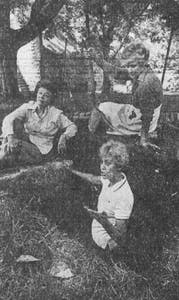Ice Houses in the South
The original Ice House (c. 1820) was about 18 feet deep and filled with ice blocks shipped from the North during the winter. The ice blocks were covered with sawdust and straw in order to protect perishable foods through the summer. Our reconstructed Ice House was built in 2018 adjacent to the original foundation that had been marked off using ground-penetrating radar (GPR). The original foundation was uncovered during an archaeological dig conducted during the summer of 1982.
Ice caves, ice pits, and spring houses have existed since ancient times around the world, but the development of the ice house was uniquely American. During the 1700s, New England farmers cut ice from their ponds and rivers to preserve their fruit and vegetables in underground ice houses and drinks were known to be served with ice during colonial times. By the early 1800s, the ice trade developed as ships carried New England ice, insulated in sawdust, to the American South.
Prior to the Civil War, ice houses were constructed across the South to store foods and other perishable items. These buildings were filled during the winter months with blocks of natural ice from local lakes and streams or brought down the Mississippi River from ice ponds in the upper Midwest.
John Harding began the construction of Belle Meade’s ice house after the completion of his six-room Federal-style home in 1820. The round shape was chosen due to its functionality, as described in this excerpt from an 1885 article in Volume 13 of The Western Manufacturer: “The best form of an icehouse would be that of a globe. Because that would have the greatest bulk with the least surface area. Such a shaped house however would be inconvenient and expensive to construct. The next best form is a cylinder. Practically, however, an inverted truncated cone will give all the advantages of a cylinder form with the further advantage of being more economical in construction and in keeping and repair. The worst possible form is a cubical or square icehouse. For the corners of the ice in such a house will always melt away and leave the mass of ice round.”
During the Civil War, ice deliveries from the North were suspended, so local ice plants began to produce what was called “mechanical” ice. This factory-produced ice impacted the interstate ice trade, which began a steep decline in the 1880s. By the 1920s, the convenience of weekly deliveries by local ice plants had completely ended the need for large, seasonal ice deliveries and storage in large ice houses. Within a decade, the advent of early electric refrigerators began replacing the need for regular ice purchasing and delivery.
Below are excerpts from an interview with John Paty, who was Director of Belle Meade Mansion at the time, in the article “Belle Meade Dig Uncovers Surprise” by Ellen Schreiber, The Tennessean, August 2, 1982.
The foundation of the ice house was uncovered during the 13-day archaeological dig, 50 feet from where it originally was believed to have stood. In addition, while volunteers were digging around the excavated ice house, the ground collapsed and they located an underground chamber that no one knew previously existed.
“They dug an exploratory shaft, approximately 12 feet deep, and before they reached the floor of the ice house, they came upon an open metal box. While they were digging between the box and the wall of the ice house, the earth gave way and opened up an entrance that is the opening to an underground chamber of some sort.”
“We had been wondering where the ice house was located, and we had thought it was by the old dairy building. Thanks to a photograph given by Mrs. Stuart Ragland just recently, we caught a glimpse of the structure right in the corner of the photograph and the archaeologist kept probing until she found it on the last day of the dig.”
“We found some charred remains. Perhaps the top structure was burned when it was no longer going to be used in order to get it out of the way, and it fell down into the hole. By that time they would be getting daily ice runs from the city of Nashville.”
Photo below: Archaeologist Jane Hinshaw stands in the exploratory shaft on the grounds of the Belle Meade Mansion which uncovered the foundation of the old ice house, 50 feet from where it originally was believed to be. With her are Anne Pirkle and Jan Scantlebury, two volunteers that helped with the dig. Staff photo by Pat Casey Daley, “Mansion’s Story Revised”, The Tennessean, August 2, 1982.


